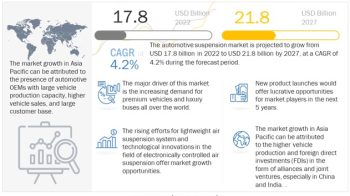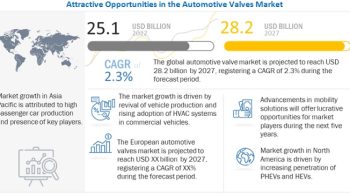
The global ADAS market is projected to grow from an estimated USD 30.9 billion in 2022 to USD 65.1 billion by 2030, registering a CAGR of 9.7%. Factors such as increasing concern for road safety, efficient R&D for ADAS component design and government mandates for vehicle safety will drive the market for ADAS systems in the coming years. The growing demand for advanced driving features in automobiles is supported by a wide network coverage of 5G connectivity and the installation of IoT devices in premium sedans and SUVs. Even budget segment vehicles are expected to have ADAS systems installed in the coming years, as per the regulations by countries in Europe and some other countries such as Japan, South Korea, China and the US.
Passenger cars comprise sedans, hatchbacks, station wagons, sports utility vehicles (SUVs), multi-utility vehicles (MUVs), and vans. This is the most promising segment and largest market for ADAS due to the growing demand for safer and more comfortable vehicles. Governments in developed and developing countries are planning to mandate ADAS systems in passenger cars. For instance, the European Union has extended the scope of mandating ADAS systems such as AEB and LDW in passenger cars. This mandate has made it compulsory for automakers to provide certain ADAS features in the region from July 2022. Countries such as South Korea have also planned to mandate AEB and LDW systems for all new passenger vehicles since 2019. OEMs such as Toyota, Tesla, Ford, Mercedes, BMW, Jaguar, and General Motors widely invest in developing ADAS systems for developing autonomous vehicles. Toyota for instance, partnered with ZF and Mobileye to develop ADAS solutions in 2021. Similarly, GM partnered with MENNDL in 2021 to develop ADAS solutions for its vehicles. Further, companies such as Continental, ZF, and Bosch are developing new ADAS solutions for low-priced cars. For instance, on November 2022, Continental announced plans to develop ADAS systems for entry-level cars in India. Thus, the growing trend of autonomous cars will boost the demand for ADAS solutions during the forecast period.
Download PDF Brochure @ https://www.marketsandmarkets.com/pdfdownloadNew.asp?id=1201
Radar (radio detection and ranging) technology transmits strong radio waves and receives waves reflected from objects. Sensors then use these waves to calculate the echo time or detect the object. Pulse-doppler radar is the most widely used variant of radar sensors in present ADAS. It sends short pulses of radio energy and concurrently listens for the echo from objects using the same antenna. Its major advantage is that it can be used for long- and short-distance ranges. Radar is not vulnerable to adverse weather and lighting conditions, unlike cameras. Growing safety awareness and the increasing number of accidents majorly drive the growth of the ADAS market, resulting in more demand for radar sensors in North America. The US Federal Communications Commission (FCC) and European Telecommunications Standards Institute (ETSI) have restricted the usage of 24 GHz radars in 5 GHz bandwidth. The 24 GHz frequency range will not be available in the ultrawideband (UWB) beyond 2022. Major OEMs and tier 1 auto component manufacturers are shifting to long-range 77 GHz radars for better reliability and compliance with regulations. This is expected to drive the demand for radar sensors in the ADAS market.
The ADAS segment is expected to reveal fast growth in the aftermarket in the coming years with a shift to EVs and increasing vehicle life cycles. Countries across Europe and North America have mandated using certain ADAS systems, such as AEB, LCA, and DMS, in new automobiles. Similarly, they also plan to mandate these systems in other vehicles. However, due to increasing vehicle life cycles and the shift to EVs, the demand for ADAS systems is expected to grow in the aftermarket segment. As per an article by Counterman Magazine, more than 1 million automobiles will require ADAS replacement or servicing every year in the next decade. This would also lead to considerable demand for ADAS systems in the aftermarket. Companies such as Bosch, Continental, ZF, Denso, Valeo, Magna International, and Aisin provide ADAS systems and components for the aftermarket segment.
China, South Korea, and Japan account for the largest share of the ADAS industry in the Asia Pacific region. The market growth in Asia Pacific can be attributed to the high vehicle production and increased use of advanced electronics in Japan, South Korea, and China. The governments of these countries have recognized the growth potential of the automotive industry and have consequently undertaken various initiatives to encourage major OEMs to enter their domestic markets. Several European and American automobile manufacturers, such as Volkswagen (Germany), Mercedes Benz (Germany), and General Motors (US), have shifted their production plants to developing countries. Major ADAS solution providers such as Robert Bosch (Germany), Continental (Germany), and Denso (Japan) have production facilities across the region. The region saw significant developments in ADAS market in the past few years. In Japan, Toyota launched a new ADAS system called “Guardian” in 2022, which uses a combination of cameras, lidar, and radar to enhance the driver’s awareness of their surroundings and assist with steering and braking. Similarly, in China, Baidu announced the completion of the first public road test of its autonomous driving system, Apollo, in Beijing. The test involved a fleet of vehicles equipped with the company’s “Apollo Pilot” system, using a combination of cameras, lidar, and radar for perception and a high-definition map for localization. Further, in South Korea, Hyundai announced that it had developed a new “SmartSense” ADAS system that uses cameras and radar to assist with lane keeping, forward collision avoidance, and adaptive cruise control. The system will be available on the company’s new vehicles.
Key Market Players
The ADAS companies are Robert Bosch (Germany), Denso (Japan), Continental AG (Germany), Magna International (US), and ZF Friedrichshafen (Germany), among others.
Request Free Sample Report @ https://www.marketsandmarkets.com/requestsampleNew.asp?id=1201


